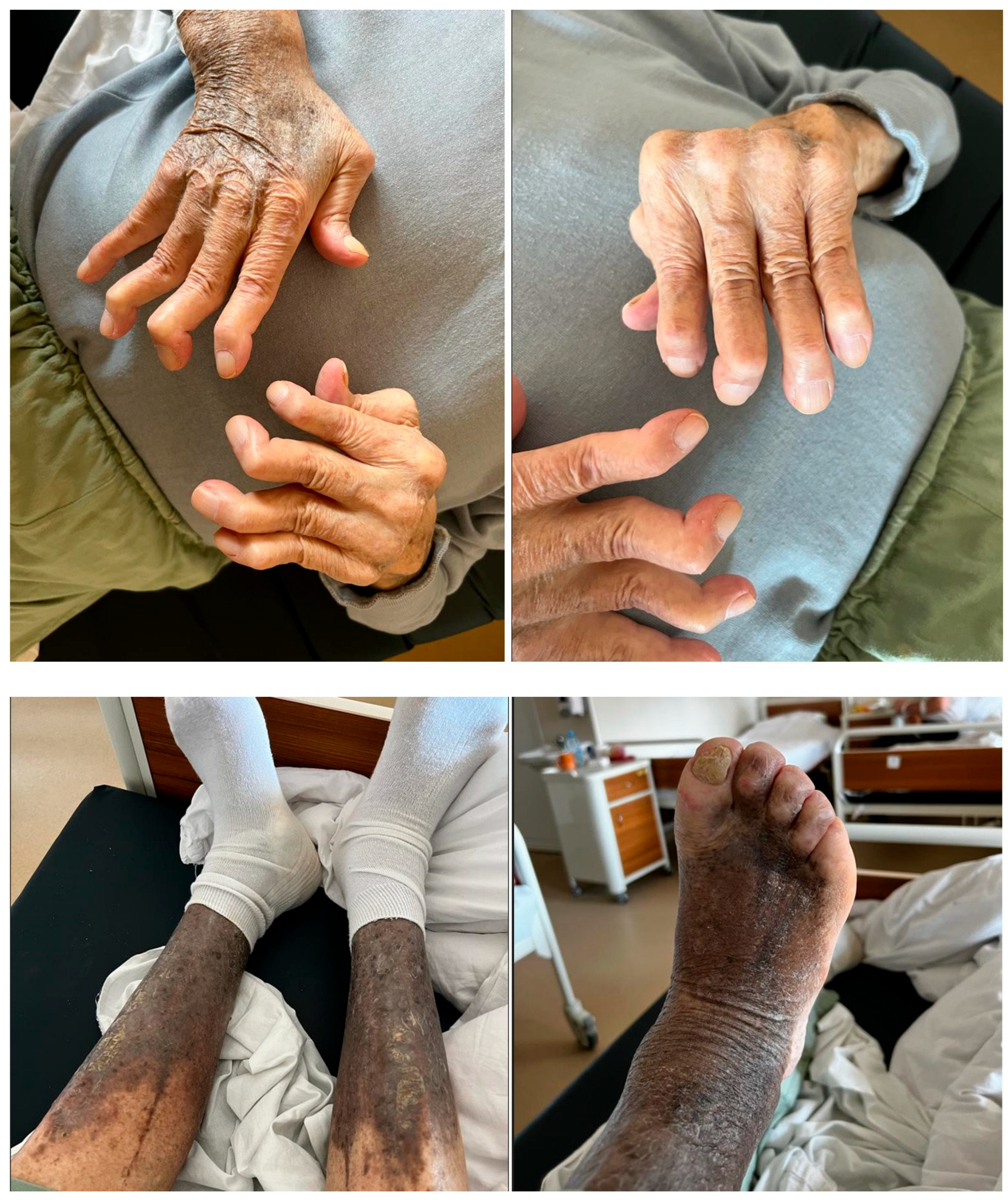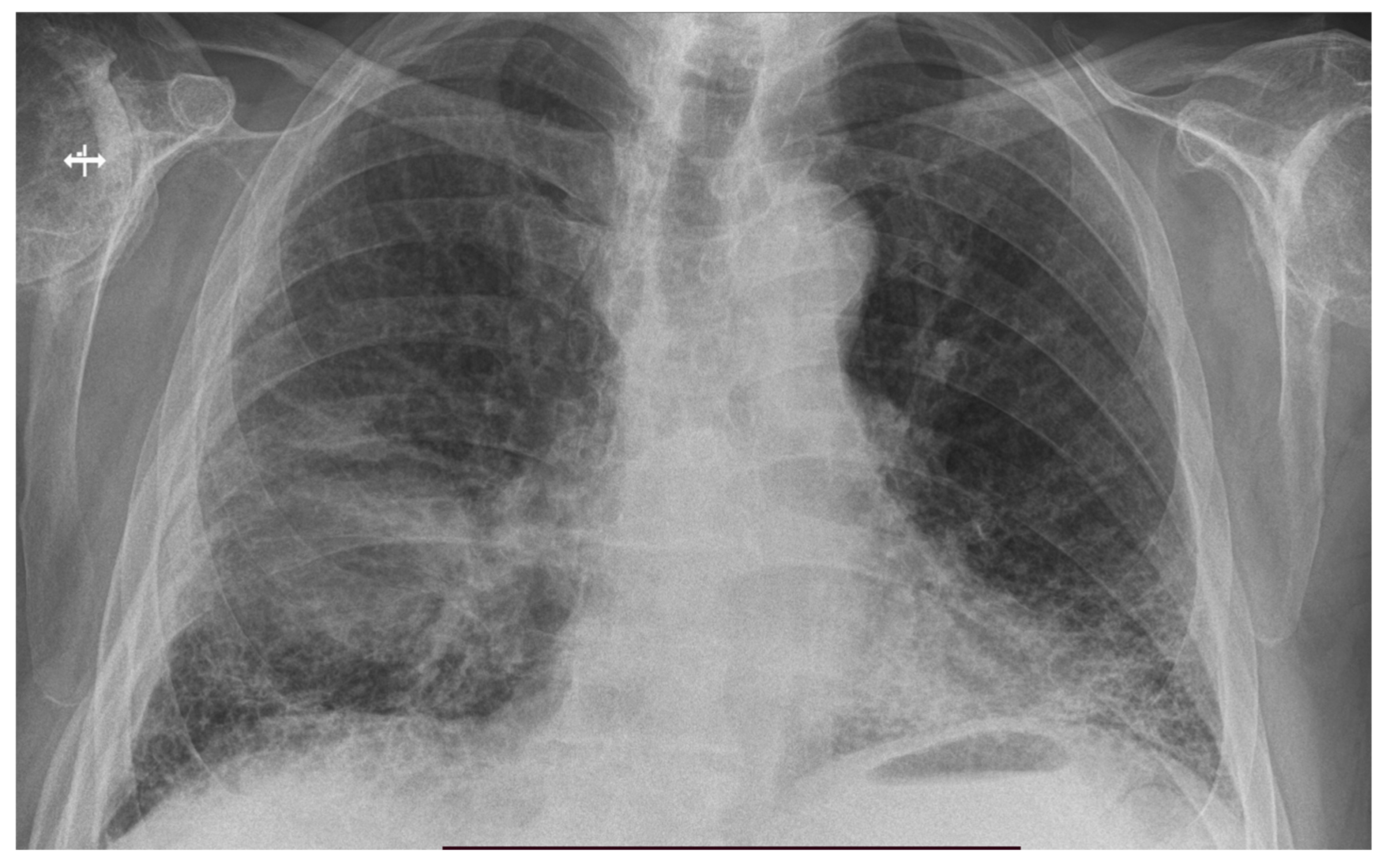Co-Occurrence of Rheumatoid Arthritis and Lung Cancer—Coincidence or Not?
Abstract
:1. Introduction
2. Materials and Methods
3. Results
4. Discussion
5. Conclusions
Author Contributions
Funding
Institutional Review Board Statement
Informed Consent Statement
Data Availability Statement
Conflicts of Interest
References
- Kourilovitch, M.; Galarza-Maldonado, C.; Ortiz-Prado, E. Diagnosis and classification of rheumatoid arthritis. J. Autoimmun. 2014, 48–49, 26–30. [Google Scholar] [CrossRef] [PubMed]
- Zhang, Y.; Lin, J.; You, Z.; Tu, H.; He, P.; Li, J.; Gao, R.; Liu, Z.; Xi, Z.; Li, Z.; et al. Cancer risks in rheumatoid arthritis patients who received immunosuppressive therapies: Will immunosuppressants work? Front. Immunol. 2022, 13, 1050876. [Google Scholar] [CrossRef] [PubMed]
- The Global Cancer Observatory—March, 2020. Available online: https://gco.iarc.fr/today/data/factsheets/populations/900-world-fact-sheets.pdf (accessed on 15 May 2023).
- Lim, X.R.; Xiang, W.; Tan, J.W.L.; Koh, L.W.; Lian, T.Y.; Leong, K.P.; Koh, E.T. TTSH Rheumatoid Arthritis Study Group. Incidence and patterns of malignancies in a multi-ethnic cohort of rheumatoid arthritis patients. Int. J. Rheum. Dis. 2019, 22, 1679–1685. [Google Scholar] [CrossRef] [PubMed]
- Solomon, D.H.; Kremer, J.M.; Fisher, M.; Curtis, J.R.; Furer, V.; Harrold, L.R.; Hochberg, M.C.; Reed, G.; Tsao, P.; Greenberg, J.D. Comparative cancer risk associated with methotrexate, other non-biologic and biologic disease-modifying anti-rheumatic drugs. Semin. Arthritis Rheum. 2014, 43, 489–497. [Google Scholar] [CrossRef] [PubMed]
- Buchbinder, R.; Barber, M.; Heuzenroeder, L.; Wluka, A.E.; Giles, G.; Hall, S.; Harkness, A.; Lewis, D.; Littlejohn, G.; Miller, M.H.; et al. Incidence of melanoma and other malignancies among rheumatoid arthritis patients treated with methotrexate. Arthritis Rheum. 2008, 59, 794–799. [Google Scholar] [CrossRef] [PubMed]
- Liu, X.; Xu, Y.; Zhou, Q.; Chen, M.; Liang, H.; Zhao, J.; Zhong, W.; Wang, M. Clinicopathological features of lung cancer in patients with rheumatoid arthritis. J. Thorac. Dis. 2018, 10, 3965–3972. [Google Scholar] [CrossRef] [PubMed]
- Zhang, L.; Zhao, Q.; Yuan, F.; Liu, M. Lung cancer in patients with and without rheumatoid arthritis: A propensity score-matched survival analysis cohort study. Thorac. Cancer 2020, 11, 1406–1413. [Google Scholar] [CrossRef] [PubMed]
- Spagnolo, P.; Lee, J.S.; Sverzellati, N.; Rossi, G.; Cottin, V. The Lung in Rheumatoid Arthritis: Focus on Interstitial Lung Disease. Arthritis Rheumatol. 2018, 70, 1544–1554. [Google Scholar] [CrossRef] [PubMed]
- Rubbert-Roth, A.; Zander, T.; Kneitz, C.; Baerwald, C.; Wirtz, H.; Witt, C. Lungenkarzinom und rheumatoide Arthritis. Eine interdisziplinäre Herausforderung [Lung cancer and rheumatoid arthritis. An interdisciplinary challenge]. Z. Rheumatol. 2016, 75, 47–53. [Google Scholar] [CrossRef] [PubMed]
- Huang, H.; Chen, R.; Shao, C.; Xu, Z.; Wolters, P.J. Diffuse lung involvement in rheumatoid arthritis: A respiratory physician’s perspective. Chin. Med. J. (Engl.) 2023, 136, 280–286. [Google Scholar] [CrossRef] [PubMed]
- Kremer, J.M.; Alarcón, G.S.; Weinblatt, M.E.; Kaymakcian, M.V.; Macaluso, M.; Cannon, G.W.; Palmer, W.R.; Sundy, J.S.; St. Clair, E.W.; Alexander, R.W.; et al. Clinical, laboratory, radiographic, and histopathologic features of methotrexate-associated lung injury in patients with rheumatoid arthritis: A multicenter study with literature review. Arthritis Rheum. 1997, 40, 1829–1837. [Google Scholar] [CrossRef] [PubMed]
- Juge, P.A.; Lee, J.S.; Lau, J.; Kawano-Dourado, L.; Rojas Serrano, J.; Sebastiani, M.; Koduri, G.; Matteson, E.; Bonfiglioli, K.; Sawamura, M.; et al. Methotrexate and rheumatoid arthritis associated interstitial lung disease. Eur. Respir. J. 2021, 57, 2000337. [Google Scholar] [CrossRef] [PubMed]
- Khurana, R.; Wolf, R.; Berney, S.; Caldito, G.; Hayat, S.; Berney, S.M. Risk of development of lung cancer is increased in patients with rheumatoid arthritis: A large case control study in US veterans. J. Rheumatol. 2008, 35, 1704–1708. [Google Scholar] [PubMed]
- Chatzidionysiou, K.; di Giuseppe, D.; Soderling, J.; Catrina, A.; Askling, J. Risk of lung cancer in rheumatoid arthritis and in relation to autoantibody positivity and smoking. RMD Open 2022, 8, e002465. [Google Scholar] [CrossRef] [PubMed]
- Khansari, N.; Shakiba, Y.; Mahmoudi, M. Chronic inflammation and oxidative stress as a major cause of age-related diseases and cancer. Recent Pat. Inflamm. Allergy Drug Discov. 2009, 3, 73–80. [Google Scholar] [CrossRef] [PubMed]
- De Cock, D.; Hyrich, K. Malignancy and rheumatoid arthritis: Epidemiology, risk factors and management. Best Pract. Res. Clin. Rheumatol. 2018, 32, 869–886. [Google Scholar] [CrossRef] [PubMed]
- Mamtani, R.; Clark, A.S.; Scott, F.I.; Brensinger, C.M.; Boursi, B.; Chen, L.; Xie, F.; Yun, H.; Osterman, M.T.; Curtis, J.R.; et al. Association Between Breast Cancer Recurrence and Immunosuppression in Rheumatoid Arthritis and Inflammatory Bowel Disease: A Cohort Study. Arthritis Rheumatol. 2016, 68, 2403–2411. [Google Scholar] [CrossRef] [PubMed]
- Bologna, C.; Picot, M.C.; Jorgensen, C.; Viu, P.; Verdier, R.; Sany, J. Study of eight cases of cancer in 426 rheumatoid arthritis patients treated with methotrexate. Ann. Rheum. Dis. 1997, 56, 97–102. [Google Scholar] [CrossRef] [PubMed]
- Solomon, D.H.; Glynn, R.J.; Karlson, E.W.; Lu, F.; Corrigan, C.; Colls, J.; Xu, C.; MacFadyen, J.; Barbhaiya, M.; Berliner, N.; et al. Adverse Effects of Low-Dose Methotrexate: A Randomized Trial. Ann. Intern. Med. 2020, 172, 369–380. [Google Scholar] [CrossRef] [PubMed]





| ACID/BASE | 37 °C | OXYGEN 37 °C | |||
| pH | 7.476 | BO2 | 15.5 | mL/dL | |
| pCO2 | 30.1 | mmHg | ctO2 | 15.3 | mL/dL |
| pO2 | 85.5 | mmHg | ELECTROLITES | ||
| HCO3− act | 21.7 | mmol/L | Na+ | 128.2 | mmol/L |
| HCO3− std | 23.6 | mmol/L | K+ | 3.22 | mmol/L |
| BE(B) | −1.1 | mmol/L | Ca++ | 0.65 | mmol/L |
| BE(ecf) | −1.9 | mmol/L | Ca++(7.4) | 0.67 | mmol/L |
| CtCO2 | 22.6 | mmol/L | Cl− | 100 | mmol/L |
| CO-OXIMETRY | AnGap | 9.7 | mmol/L | ||
| Hct | 33 | % | mOsm | 261.3 | mmol/kg |
| tHb | 11.2 | g/dL | METABOLITES | ||
| sO2 | 96.9 | % | Glu | 89 | mg/dL |
| FO2Hb | 96.5 | % | Lac | 1.75 | mmol/L |
| FCOHb | 0.1 | % | pAtm | 760 | mmHg |
| FMetHb | 0.3 | ||||
| FHHb | 3.1 |
| Pred | Pred LL | Test | Test 2 | % (Test) | |||
|---|---|---|---|---|---|---|---|
| VC MAX | L | 3.97 | 3.05 | 2.84 | 71,6 | % | |
| FVC | L | 3.83 | 2.83 | 2.84 | 74.1 | % | |
| FEV1 | L | 2.84 | 2.01 | 2.12 | 74.7 | % | |
| FEV1%M | % | 72.81 | 61.02 | 74.73 | 102.6 | % | |
| FEV1%F | % | 72.81 | 61.02 | 74.73 | 102.6 | % | |
| PEF | L/s | 7.64 | 5.65 | 3.90 | 51.1 | % | |
| MEF50 | L/s | 3.92 | 1.74 | 2.77 | 70.7 | % | |
| MEF50% | % | 102.18 | 102.18 | 97.37 | 95.3 | % | |
| FET | sec | 4.19 | |||||
| VBEex | L | 0.14 | |||||
| VBe%FV | % | 4.99 | |||||
| Level date | 2 August 2023 | 2 August 2023 | |||||
| Level time | 11:57 A.M. | 11:58 A.M. |
| Plethysmography | |||||
|---|---|---|---|---|---|
| R tot | [kPa*s/L] | 0.30 | 0.30 | 0.27 | 91.4 |
| SG tot | [1/(kPa*s)] | 0.85 | 0.85 | 1.03 | 120.7 |
| FRCpleth | [L] | 3.80 | 2.81 | 3.03 | 79.7 |
| RV | [L] | 2.86 | 2.19 | 2.19 | 76.7 |
| TLC | [L] | 7.14 | 5.99 | 4.83 | 67.7 |
| VC IN | [L] | 3.97 | 3.05 | 2.64 | 66.5 |
| FVC | [L] | 3.83 | 2.83 | 2.57 | 66.9 |
| FEV1 | [L] | 2.84 | 2.01 | 2.23 | 78.4 |
| FEV1% VC MAX | [%] | 72.81 | 61.05 | 84.44 | 116.0 |
| FEV1% FVC | [%] | 86.88 | |||
| PEF | [L/s] | 7.64 | 5.65 | 4.74 | 62.0 |
| MEF 50 | [L/s] | 3.92 | 1.75 | 3.60 | 92.0 |
| MEF 50% FVC | [%] | 102.18 | 102.18 | 140.41 | 137.4 |
| FET | [s] | 3.20 | |||
| FEV6 | [L] | ||||
| Vbackextrapolation ex | [L] | 0.12 | |||
| Vbackextrapol.% FVC | [%] | 4.68 | |||
| DLCO | |||||
| DLCO SB | [mmol/min/kPa] | 8.47 | 6.15 | 3.76 | 44.5 |
| DLCO/VA | [mmol/min/kPa/L] | 1.19 | 0.81 | 0.92 | 77.2 |
| Hb | [g/100 mL] | 14.60 | |||
| DLCOc SB | [mmol/min/kPa] | 8.47 | 6.15 | 3.76 | 44.5 |
| DLCOc/VA | [mmol/min/kPa/L] | 1.19 | 0.81 | 0.92 | 77.2 |
| TA | [s] | 10.90 | |||
| VA | [L] | 6.99 | 6.99 | 4.11 | 58.8 |
| VIN | [L] | 3.97 | 3.05 | 2.62 | 66.1 |
| Discard vol | [L] | 0.75 | |||
| Sample vol | [L] | 0.60 | |||
| Insp. time | [s] | 0.50 | |||
| Exp. time | [s] | 0.60 | |||
| TLC-SB | [L] | 7.14 | 5.99 | 4.29 | 60.1 |
| FRC-SB | [L] | 3.80 | 2.81 | 2.50 | 65.8 |
| RV-SB | [L] | 2.86 | 2.19 | 1.67 | 58.2 |
Disclaimer/Publisher’s Note: The statements, opinions and data contained in all publications are solely those of the individual author(s) and contributor(s) and not of MDPI and/or the editor(s). MDPI and/or the editor(s) disclaim responsibility for any injury to people or property resulting from any ideas, methods, instructions or products referred to in the content. |
© 2023 by the authors. Licensee MDPI, Basel, Switzerland. This article is an open access article distributed under the terms and conditions of the Creative Commons Attribution (CC BY) license (https://creativecommons.org/licenses/by/4.0/).
Share and Cite
Munteanu, I.; Gheorghevici, C.; Coca, C.C.; Diaconu, G.A.; Sandru, A.E.; Feraru, N.; Popa, A.; Nemes, R.; Mahler, B. Co-Occurrence of Rheumatoid Arthritis and Lung Cancer—Coincidence or Not? Life 2023, 13, 2089. https://doi.org/10.3390/life13102089
Munteanu I, Gheorghevici C, Coca CC, Diaconu GA, Sandru AE, Feraru N, Popa A, Nemes R, Mahler B. Co-Occurrence of Rheumatoid Arthritis and Lung Cancer—Coincidence or Not? Life. 2023; 13(10):2089. https://doi.org/10.3390/life13102089
Chicago/Turabian StyleMunteanu, Ioana, Constantin Gheorghevici, Catalin Constantin Coca, George Alexandru Diaconu, Alexandra Emilia Sandru, Nicolae Feraru, Andreea Popa, Roxana Nemes, and Beatrice Mahler. 2023. "Co-Occurrence of Rheumatoid Arthritis and Lung Cancer—Coincidence or Not?" Life 13, no. 10: 2089. https://doi.org/10.3390/life13102089
APA StyleMunteanu, I., Gheorghevici, C., Coca, C. C., Diaconu, G. A., Sandru, A. E., Feraru, N., Popa, A., Nemes, R., & Mahler, B. (2023). Co-Occurrence of Rheumatoid Arthritis and Lung Cancer—Coincidence or Not? Life, 13(10), 2089. https://doi.org/10.3390/life13102089







